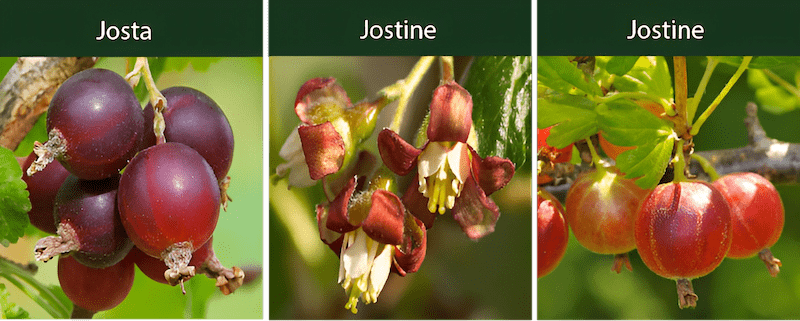
Currants are small, flavorful berries that grow on shrubs like blueberries and blackberries do, and they come in a range of colors and flavors. They are a part of the Ribes genus of plants and are often used in culinary applications for their distinct, vibrant flavors that can range from sweet to quite tart.
Red currants (Ribes rubrum) are perhaps the most recognized variety. They are known for their bright, glossy red appearance and tart flavor. Red currants are often used in jams, jellies, and sauces, and are appreciated for their high pectin content which aids in thickening. There are many varieties of red currants, with 'Jonkheer Van Tets', 'Rovada', and 'Red Lake' being some of the most popular due to their balance of sweetness and tartness, and reliable yield.
Black currants (Ribes nigrum) are notably different in flavor, with a deeper, more intense tartness and complexity. These berries are often used in syrups, jams, and even in liqueurs such as the French Crème de Cassis. Some popular varieties of black currants include 'Ben Sarek', 'Ben Lomond', and 'Titania', each prized for their respective balances of yield, berry size, and disease resistance.
White currants are usually lighter-colored variants of the red currants. These berries are typically milder and sweeter than the red varieties, with 'White Pearl' and 'White Versailles' being two well-known types. They are often eaten fresh or used in dishes where a less tart flavor is desired.
Pink currants, on the other hand, offer a unique, delicate flavor and color. The 'Gloire des Sablons', also known as Pink Champagne, is a notable variety producing pinkish berries with a mild, sweet flavor.
The Jostaberry is a more recent addition to the currant family. It is a cross between the black currant, the North American coastal black gooseberry, and the European gooseberry, resulting in a larger berry with a flavor closer to a black currant. 'Josta', 'Jostine', and 'Jogranda' are among the known variants of this berry.
Each type of currant offers unique flavors and characteristics, making them a versatile choice for gardening and cooking. Their diverse range of flavors makes them an excellent choice for a variety of culinary applications, from sweet to savory dishes, while their vibrant colors can liven up any garden.
Red currants (Ribes rubrum) are small, round fruits that grow on deciduous shrubs native to western Europe. They are known for their bright red color, glossy sheen, and a tart flavor, often used in jams, jellies, sauces, and desserts due to their pectin content and distinctive taste.
Jonkheer Van Tets: This variety is early fruiting and known for its high yield.
Rovada: Known for its late maturity, this variety produces large, sweet berries on long strings.
Red Lake: A popular variety in the United States, it produces large, sweet berries.
Stanza: This variety is known for its strong growth and heavy yield.
Redstart: An early fruiting variety, 'Redstart' is known for its large berries.
Rotet: This variety is resistant to diseases and known for its high yield of large berries.
Junifer: An early fruiting variety, it is resistant to mildew and known for its heavy yield.
Detvan: This variety has a medium growth rate and produces sweet, large berries.
Roland: Known for its late maturity, this variety produces large berries.
Rosetta: This variety is late fruiting and known for its very sweet, large berries.
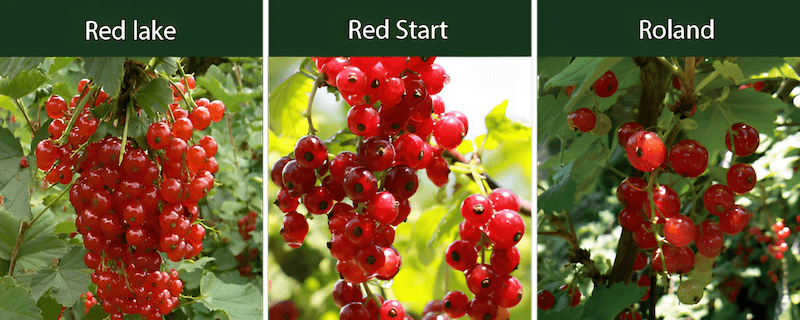
Black currants (Ribes nigrum) are small, dark purple berries that grow on perennial shrubs native to temperate parts of central and northern Europe and northern Asia. They are highly valued for their intense, tart flavor and are widely used in culinary applications such as syrups, jams, jellies, and desserts, as well as being a key ingredient in the liqueur known as Crème de Cassis.
Ben Sarek: Compact and suitable for smaller gardens, this variety is resistant to mildew and produces large, high-quality fruit.
Ben Hope: This variety is resistant to reversion virus and produces heavy crops of medium-sized berries.
Ben Lomond: One of the most common types due to its resistance to frost and mildew. It produces large fruits and has a high yield.
Ben Connan: Known for its large and sweet berries, this variety is resistant to mildew and has a high yield.
Ben Tirran: This late-fruiting variety is resistant to reversion virus and produces small to medium-sized berries.
Big Ben: As the name suggests, this variety produces very large berries. It's resistant to frost and has a good yield.
Titania: A Swedish variety, 'Titania' is known for its resistance to disease and produces large, sweet berries.
Ojebyn: Another Swedish variety, it's valued for its productivity and hardiness in cold climates.
Goliath: An older variety known for its large berries and high yield.
Wellington XXX: A New Zealand variety, it's known for its strong black currant flavor and productivity.
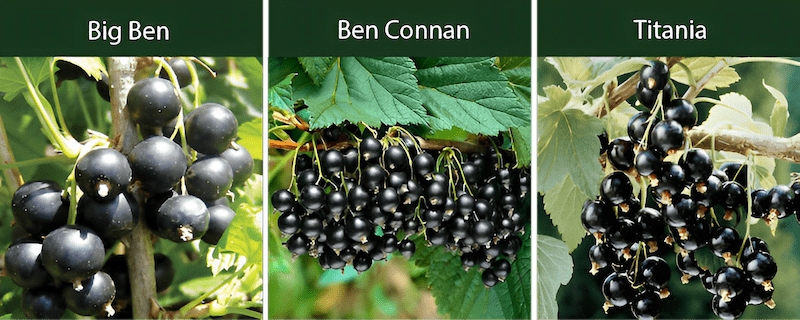
White currants are a type of currant that is often a white or light-colored variant of red currants. They are usually milder and sweeter than their red counterparts. Here are a few varieties of white currants:
White Pearl: A variety that yields a high quantity of sweet, light-yellow berries.
White Imperial: Known for its large, sweet berries and vigorous growth habit.
White Versailles: An older variety known for its large, sweet berries.
Primus: This variety has a high yield and produces aromatic, sweet berries.
Zitavia: Known for its high yield of medium to large, flavorful berries.
Blanka: This variety produces large clusters of sweet, yellowish-white berries.
Gloire des Sablons: Also known as Pink Champagne, this variety actually produces pinkish berries with a sweet flavor.
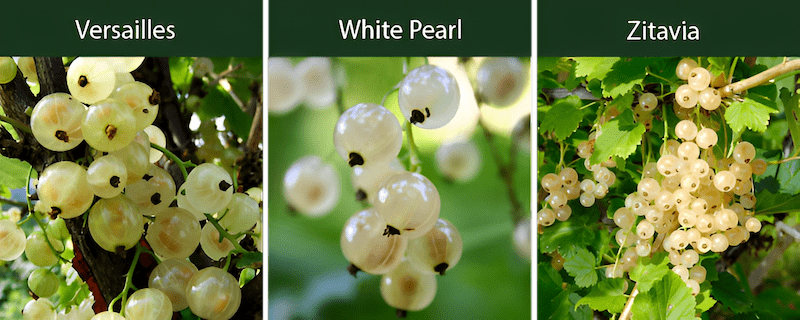
Pink currants are less common than their red, white, and black counterparts, but they offer a unique, delicate flavor and color that can be a great addition to your garden. Here are a few varieties of pink currants:
Gloire des Sablons: Also known as Pink Champagne, this variety produces pinkish berries with a sweet, delicate flavor. It's often considered a type of white currant, but the color is closer to pink.
Pink Jules: This variety is known for its hardiness and productivity, with clusters of vibrant pink berries.
Cascade: This variety yields a high volume of translucent pink berries and is prized for its resistance to mildew.
Rosa Sport: An early ripening currant bush that produces pale pink, sweet fruit.
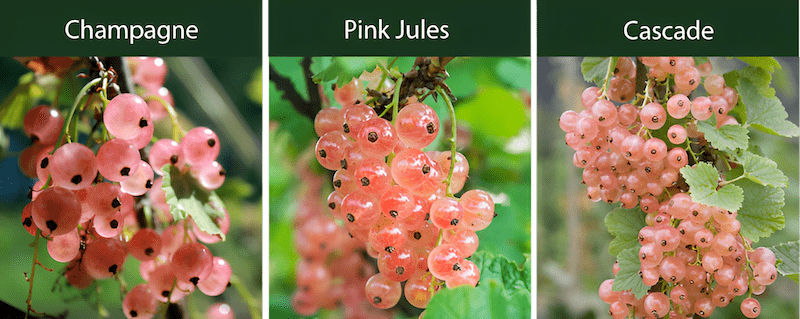
The Jostaberry is a complex-cross fruit that is a cross between the black currant, the North American coastal black gooseberry, and the European gooseberry. The fruit is larger than a black currant and unlike other currants, it doesn't have a musky scent. The Jostaberry is relatively new and there are not as many varieties compared to other berries. Here are a few known varieties:
Northcountry: A variety known for its sweet, wild flavor, Northcountry produces medium-sized berries and has a compact growth habit, making it excellent for small gardens or containers.
Josta: This is the most common variety and is often what people refer to when they talk about Jostaberries. The bushes can grow quite large, and the berries are bigger and sweeter than most black currants.
Jostine: This variety is slightly smaller than 'Josta' but produces a higher yield of berries.
Jogranda: A variant known for its slightly larger and juicier berries.
